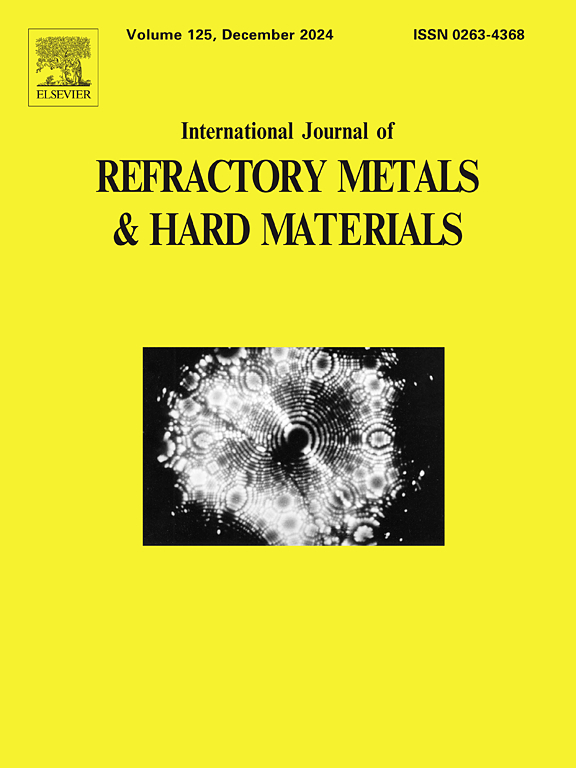钨基耐火材料激光粉末床分层轧制熔接:效果及机理
IF 4.6
2区 材料科学
Q2 MATERIALS SCIENCE, MULTIDISCIPLINARY
International Journal of Refractory Metals & Hard Materials
Pub Date : 2025-05-17
DOI:10.1016/j.ijrmhm.2025.107235
引用次数: 0
摘要
钨(W)具有所有金属中最高的熔点(3422°C),热稳定性和机械强度,是从航空航天和核聚变反应堆到高温制造等苛刻应用的首选材料。然而,钨在增材制造工艺中的应用受到其高韧脆转变温度(DBTT)导致的裂纹倾向的限制。在这些过程中,钨经历了反复的热循环,并经常冷却到其DBTT以下,进入脆性状态,从而促进裂纹的形成,进而影响制造部件的微观结构、机械性能和可靠性。这种开裂是增材制造技术面临的主要挑战;然而,目前的研究主要集中在激光粉末床熔融(LPBF)作为一个代表性的过程来研究这个问题。为了解决这一挑战,我们引入了一种称为冷轧辅助激光粉末床熔合(CR-LPBF)的新方法,其中LPBF的每一层都在高于钨的DBTT的温度下进行冷轧,然后才开始开裂。假设这种原位分层轧制导致每层内晶粒均匀细分,从而减小位错源间距(λ)并增加位错密度。由此产生的高位错密度有望提高材料的塑性变形能力,抑制裂纹的形成,从而改善材料的整体力学性能。实验结果表明,在LPBF过程中加入分层冷轧步骤可以显著减少裂纹并细化晶粒组织;这种结合的方法也增加了位错密度,从而提高了制造的钨零件的机械性能。据我们所知,这项工作首次成功地将冷轧集成到LPBF工艺中,从而为克服传统制造的局限性提供了一种新的策略。通过CR-LPBF技术获得的这些增强性能为钨在高温和严重机械应力的关键应用中更广泛的应用铺平了道路。本文章由计算机程序翻译,如有差异,请以英文原文为准。
Layerwise rolling in laser powder bed fusion of tungsten refractory materials: Effects and mechanisms
Tungsten (W), which possesses the highest melting point of any metal (3422 °C) and thermal stability and mechanical strength, is a material of choice for extremely demanding applications ranging from aerospace and nuclear fusion reactors to high-temperature manufacturing. However, tungsten's use in additive manufacturing processes is limited by its tendency to crack due to its high ductile-to-brittle transition temperature (DBTT). During these processes, tungsten undergoes repeated thermal cycling and often cools below its DBTT, entering a brittle regime that promotes crack initiation and, in turn, compromises the microstructure, mechanical performance, and reliability of fabricated parts. Such cracking is a major challenge across additive manufacturing techniques; however, the present study concentrates on laser powder bed fusion (LPBF) as a representative process to examine this issue. To address this challenge, we introduce a novel approach termed cold rolling assisted laser powder bed fusion (CR-LPBF), wherein each layer of the LPBF build is cold-rolled at a temperature above tungsten's DBTT prior to the onset of cracking. It is hypothesized that this in situ layerwise rolling induces uniform grain subdivision within each layer, thereby reducing the dislocation source spacing (λ) and increasing the dislocation density. The resultant high dislocation density is anticipated to enhance the material's capacity for plastic deformation, inhibit the formation of cracks, and thereby improve the material's overall mechanical properties. Consistent with this expectation, experimental results indicate that incorporating a layerwise cold-rolling step into the LPBF process significantly reduces cracking and refines the grain structure; this combined approach also increases the dislocation density and, in turn, enhances the mechanical performance of the fabricated tungsten parts. To the best of our knowledge, this work constitutes the first successful integration of cold rolling into an LPBF process, thus offering a novel strategy to overcome the limitations of conventional manufacturing. These enhanced properties achieved through the CR-LPBF technique pave the way for broader deployment of tungsten in critical applications involving high temperatures and severe mechanical stresses.
求助全文
通过发布文献求助,成功后即可免费获取论文全文。
去求助
来源期刊
CiteScore
7.00
自引率
13.90%
发文量
236
审稿时长
35 days
期刊介绍:
The International Journal of Refractory Metals and Hard Materials (IJRMHM) publishes original research articles concerned with all aspects of refractory metals and hard materials. Refractory metals are defined as metals with melting points higher than 1800 °C. These are tungsten, molybdenum, chromium, tantalum, niobium, hafnium, and rhenium, as well as many compounds and alloys based thereupon. Hard materials that are included in the scope of this journal are defined as materials with hardness values higher than 1000 kg/mm2, primarily intended for applications as manufacturing tools or wear resistant components in mechanical systems. Thus they encompass carbides, nitrides and borides of metals, and related compounds. A special focus of this journal is put on the family of hardmetals, which is also known as cemented tungsten carbide, and cermets which are based on titanium carbide and carbonitrides with or without a metal binder. Ceramics and superhard materials including diamond and cubic boron nitride may also be accepted provided the subject material is presented as hard materials as defined above.

 求助内容:
求助内容: 应助结果提醒方式:
应助结果提醒方式:


